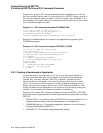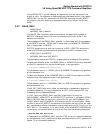
Getting Started with DECTPU
2.6 Using OpenVMS EDIT/TPU Command Qualifiers
The choice of character set also affects how your text appears when printed. For
the text displayed in DECTPU to look the same when printed, you must choose
the same character set for both DECTPU and the printer.
There are two ways to specify the character set you want to use:
• Define the TPU$CHARACTER_SET logical name to specify the character set.
This lets you use that character set for all editing sessions—including
when you invoke DECTPU within MAIL or other utilities. You can put the
definition in your LOGIN.COM file. For example, the following commands
define TPU$CHARACTER_SET as ISO_LATIN1 and then use that character
set to invoke DECTPU:
$ DEFINE TPU$CHARACTER_SET ISO_LATIN1
$ EDIT/TPU
• Use /CHARACTER_SET= and specify the character set on the command line.
This overrides any definition of the TPU$CHARACTER_SET logical name.
By default, DECTPU uses the DEC_MCS character set. For example, the
following command specifies the GENERAL character set to invoke DECTPU.
DECTPU uses the current character set to display 8-bit characters and does
not use the default DEC Supplemental Graphics character set.
$ EDIT/TPU/CHARACTER_SET=general
If the character set you specify either with /CHARACTER_SET or by defining
TPU$CHARACTER_SET is invalid, the editing session is aborted, returning you
to the DCL level.
Table 2–3 shows the values you can specify with the /CHARACTER_SET qualifier
or the TPU$CHARACTER_SET logical name.
Table 2–3 Character Set Values You Can Set with /CHARACTER_SET
Value Description
DEC_MCS This is the default setting that uses the DEC Supplemental
Graphics character set containing supplemental and
multinational characters, such as letters with accents and
umlauts.
ISO_LATIN1 This character set contains supplemental and multinational
characters that contain LATIN1 characters, such as the non-
breaking space, multiplication and division signs, and the
trademark sign.
GENERAL DECTPU does not specify a character set for 8-bit characters.
8-bit characters are displayed the same as they were before
you started DECTPU.
2.6.2 /COMMAND
/COMMAND[[=filespec]]
/NOCOMMAND
/COMMAND=TPU$COMMAND.TPU (default)
The /COMMAND qualifier determines whether DECTPU compiles and executes
a command file (a file of DECTPU procedures and statements) at startup time.
Command files extend or modify a DECTPU-based application or create a new
application. The default file type for DECTPU command files is .TPU. You cannot
use wildcards in the file specification.
2–10 Getting Started with DECTPU


















